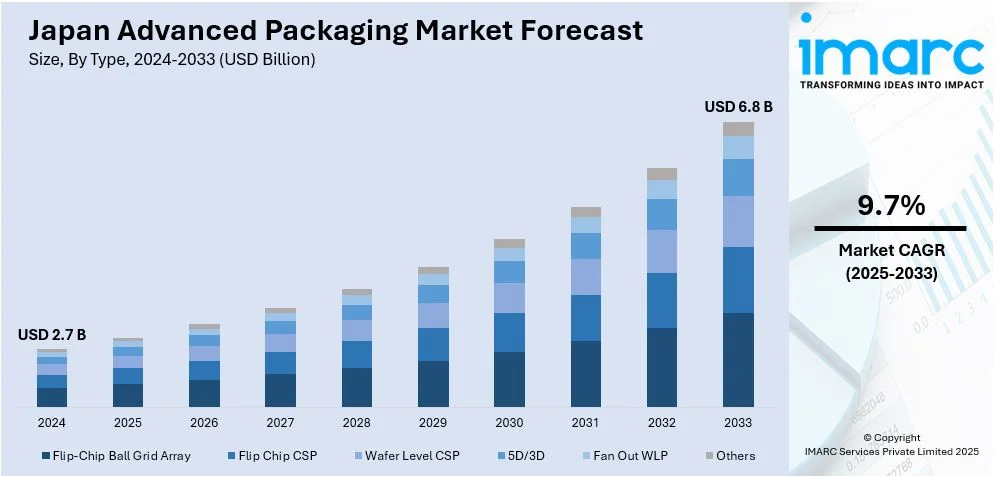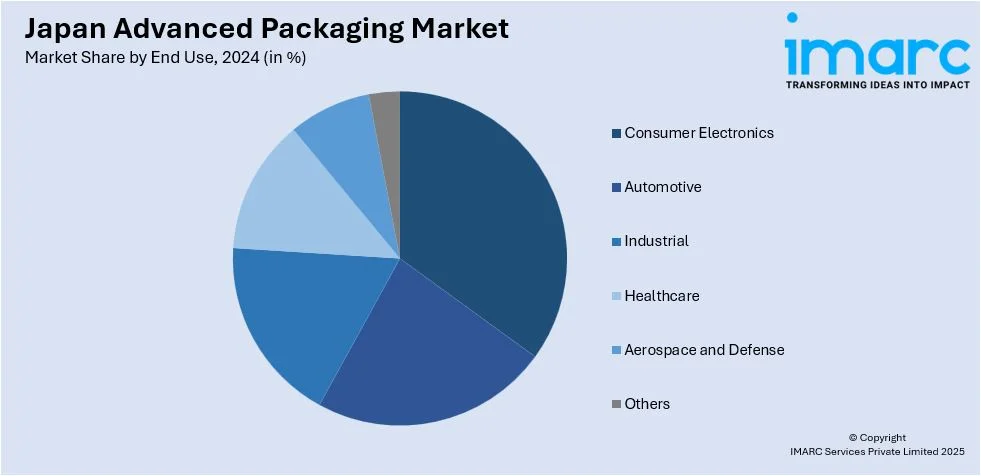
Japan Advanced Packaging Market Size, Share, Trends and Forecast by Type, End Use, and Region, 2025-2033
Japan Advanced Packaging Market Overview:
The Japan advanced packaging market size reached USD 2.7 Billion in 2024. Looking forward, IMARC Group expects the market to reach USD 6.8 Billion by 2033, exhibiting a growth rate (CAGR) of 9.7% during 2025-2033. The growing demand for compact, high-performance electronics, increasing adoption of AI and 5G technologies, rising investments in semiconductor research and development (R&D) activities, expansion of automotive electronics, and government support for domestic chip manufacturing are driving the growth of the market in Japan and encouraging innovation and production efficiency across multiple sectors.
|
Report Attribute
|
Key Statistics
|
|---|---|
|
Base Year
|
2024 |
|
Forecast Years
|
2025-2033
|
|
Historical Years
|
2019-2024
|
| Market Size in 2024 | USD 2.7 Billion |
| Market Forecast in 2033 | USD 6.8 Billion |
| Market Growth Rate 2025-2033 | 9.7% |
Japan Advanced Packaging Market Trends:
Integration of Advanced Packaging in Power Electronics and EV Applications
The electrification of transport is facilitating Japan advanced packaging market growth, particularly in the power electronics segment. According to an industry report, the Japanese government has set goals to reduce 42% of CO2 emissions from fiscal year 2013 to fiscal year 2030 and to have 100% of new light-duty vehicle (LDV) sales be electric vehicles (EVs) by 2035. As electric vehicles (EVs) become central to Japan’s decarbonization and energy transition strategy, there is a pressing need for packaging technologies that support high-voltage, high-temperature semiconductor devices. Moreover, wide bandgap materials such as silicon carbide (SiC) and gallium nitride (GaN) are increasingly utilized in EV inverters, converters, and onboard chargers, necessitating specialized packaging approaches. In addition to this, advanced packaging for power modules, like double-sided cooling and embedded die packaging, is witnessing growing adoption in Japan to manage heat dissipation and ensure mechanical robustness under harsh conditions. Besides this, Japanese companies are advancing proprietary packaging designs tailored for automotive-grade power ICs. These include ceramic substrates, high thermal conductivity interfaces, and sintering techniques to improve reliability and efficiency. Furthermore, the implementation of government initiatives to promote EV adoption and energy efficiency is further encouraging domestic supply chain development for high-performance packaging technologies.

Rising Investments in Domestic Semiconductor Activities Propelling Advanced Packaging Demand
Japan is witnessing a surge in domestic investments across the semiconductor value chain, which is significantly driving the demand for advanced packaging technologies. The Japanese government and private sector are channeling funds into bolstering domestic semiconductor manufacturing and backend processes, including packaging and testing. This is creating a positive Japan advanced packaging market outlook. Apart from this, strategic initiatives, such as subsidies under the Ministry of Economy, Trade and Industry (METI), are supporting the establishment and expansion of local semiconductor fabrication and packaging facilities. For instance, the Japanese government committed over USD 13 Billion to boost semiconductor production, which is expected to increase advanced packaging innovations. In line with this, global players are partnering with Japanese firms to set up advanced nodes and backend production units in the country. Also, increasing investments in advanced packaging methods, including 2.5D/3D integration, wafer-level packaging, and chipset architectures, are augmenting Japan advanced packaging market share. All of these are essential to meet the performance demands of AI, HPC, and automotive electronics. This investment wave is also creating a ripple effect on equipment suppliers, materials manufacturers, and design service providers in Japan, reinforcing a comprehensive ecosystem for high-performance, next-generation packaging solutions.
Japan Advanced Packaging Market Segmentation:
IMARC Group provides an analysis of the key trends in each segment of the market, along with forecasts at the country level for 2025-2033. Our report has categorized the market based on type and end use.
Type Insights:
- Flip-Chip Ball Grid Array
- Flip Chip CSP
- Wafer Level CSP
- 5D/3D
- Fan Out WLP
- Others
The report has provided a detailed breakup and analysis of the market based on the type. This includes flip-chip ball grid array, flip chip CSP, wafer level CSP, 5D/3D, fan out WLP, and others.
End Use Insights:

- Consumer Electronics
- Automotive
- Industrial
- Healthcare
- Aerospace and Defense
- Others
A detailed breakup and analysis of the market based on the end use have also been provided in the report. This includes consumer electronics, automotive, industrial, healthcare, aerospace and defense, and others.
Regional Insights:
- Kanto Region
- Kansai/Kinki Region
- Central /Chubu Region
- Kyushu-Okinawa Region
- Tohoku Region
- Chugoku Region
- Hokkaido Region
- Shikoku Region
The report has also provided a comprehensive analysis of all the major regional markets, which include Kanto Region, Kansai/Kinki Region, Central /Chubu Region, Kyushu-Okinawa Region, Tohoku Region, Chugoku Region, Hokkaido Region, and Shikoku Region.
Competitive Landscape:
The market research report has also provided a comprehensive analysis of the competitive landscape. Competitive analysis such as market structure, key player positioning, top winning strategies, competitive dashboard, and company evaluation quadrant has been covered in the report. Also, detailed profiles of all major companies have been provided.
Japan Advanced Packaging Market News:
- On May 30, 2024, Samsung Electronics announced the expansion of its workforce at the Advanced Packaging Laboratory (APL) in Yokohama, Japan, to accelerate the development of next-generation semiconductor packaging technologies. The facility, set to commence operations in 2025, will house over 100 R&D personnel focusing on AI and 5G back-end process technologies, including applications for sixth-generation High-Bandwidth Memory (HBM4). This initiative involves a total investment of JPY 40 Billion (approximately USD 260 Million), with the Japanese government providing a subsidy covering half of the investment, sourced from its "Post-5G Fund."
Japan Advanced Packaging Market Report Coverage:
| Report Features | Details |
|---|---|
| Base Year of the Analysis | 2024 |
| Historical Period | 2019-2024 |
| Forecast Period | 2025-2033 |
| Units | Billion USD |
| Scope of the Report | Exploration of Historical Trends and Market Outlook, Industry Catalysts and Challenges, Segment-Wise Historical and Future Market Assessment:
|
| Types Covered | Flip-Chip Ball Grid Array, Flip Chip CSP, Wafer Level CSP, 5D/3D, Fan Out WLP, Others |
| End Uses Covered | Consumer Electronics, Automotive, Industrial, Healthcare, Aerospace and Defense, Others |
| Regions Covered | Kanto Region, Kansai/Kinki Region, Central /Chubu Region, Kyushu-Okinawa Region, Tohoku Region, Chugoku Region, Hokkaido Region, Shikoku Region |
| Customization Scope | 10% Free Customization |
| Post-Sale Analyst Support | 10-12 Weeks |
| Delivery Format | PDF and Excel through Email (We can also provide the editable version of the report in PPT/Word format on special request) |
Key Questions Answered in This Report:
- How has the Japan advanced packaging market performed so far and how will it perform in the coming years?
- What is the breakup of the Japan advanced packaging market on the basis of type?
- What is the breakup of the Japan advanced packaging market on the basis of end use?
- What is the breakup of the Japan advanced packaging market on the basis of region?
- What are the various stages in the value chain of the Japan advanced packaging market?
- What are the key driving factors and challenges in the Japan advanced packaging market?
- What is the structure of the Japan advanced packaging market and who are the key players?
- What is the degree of competition in the Japan advanced packaging market?
Key Benefits for Stakeholders:
- IMARC’s industry report offers a comprehensive quantitative analysis of various market segments, historical and current market trends, market forecasts, and dynamics of the Japan advanced packaging market from 2019-2033.
- The research report provides the latest information on the market drivers, challenges, and opportunities in the Japan advanced packaging market.
- Porter's five forces analysis assist stakeholders in assessing the impact of new entrants, competitive rivalry, supplier power, buyer power, and the threat of substitution. It helps stakeholders to analyze the level of competition within the Japan advanced packaging industry and its attractiveness.
- Competitive landscape allows stakeholders to understand their competitive environment and provides an insight into the current positions of key players in the market.
Need more help?
- Speak to our experienced analysts for insights on the current market scenarios.
- Include additional segments and countries to customize the report as per your requirement.
- Gain an unparalleled competitive advantage in your domain by understanding how to utilize the report and positively impacting your operations and revenue.
- For further assistance, please connect with our analysts.
 Request Customization
Request Customization
 Speak to an Analyst
Speak to an Analyst
 Request Brochure
Request Brochure
 Inquire Before Buying
Inquire Before Buying




.webp)




.webp)












